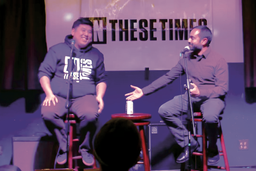Congratulations: You have lived long enough to cringe at the bad decisions you were seduced, dared, bullied, inspired or stoned enough to make as a teenager.
Thousands of America’s children, however, are not so lucky. Almost 600,000 of America’s 1 million active and reserve soldiers enlisted as teens. The military lures these physiologically immature kids with a PR machine that would make Joe Camel proud.
While the age of legal and cultural adulthood can vary, science is now able to determine the physiological markers of maturity. A recent study headed by Jay Giedd of the National Institutes of Health using MRI scans shows that the brain of an 18-year-old is not fully developed, with the limbic cortex-brain structures, the cerebellum and prefrontal cortex still undergoing substantial changes.
As of March 31, the U.S. military included 81,000 teenagers. Its 7,350 17-year-olds needed parental consent to enlist, and only this April were all barred from battle zones.
But the military aims even lower, marketing itself to children as young as 13 with multimedia videos, school visits and cold calls to teens’ homes and cell phones. In Junior ROTC, kids get uniforms, win medals, fire real guns and play soldier, while adults trained in psychological manipulation steer them toward the army. The Army’s JROTC website lists such motivating activities as “eating at concession stands.”
A mature prefrontal cortex, “the area of sober second thought,” is vital not only to deciding whether to enlist, but also to choices made under the stress of deployment and the terrors of combat. But the prefrontal cortex, “important for controlling impulses, is among the last brain regions to mature,” according to Giedd, and doesn’t reach “adult dimensions until the early 20s.”
Teenagers’ brains simply lack the impulse control that can prevent a lifetime of regret, psychological and physical disability, and preventable deaths – their own, their fellow soldiers’ and those of civilians.
The child soldier problem is global and so is America’s role in it. More than 300,000 children around the world, some as young as seven, serve as soldiers, or, in the case of girls, as military sex slaves. The State Department reports that 10 countries are violating international treaties against child soldiers. Washington provides military assistance to nine of these outlaw nations: Afghanistan, Burundi, Chad, Colombia, Ivory Coast, Democratic Republic of Congo, Sri Lanka, Sudan and Uganda.
The reason the United States and other militaries target children is their need for cannon fodder, coupled with the vulnerability of youth. In 2002, almost half of Marine recruits were 17 or 18. A Pentagon survey found that “for both males and females, propensity [to enlist] is highest among 16- and 17-year-olds.” That “propensity” quickly declines with age.
A 2004 Pentagon database listed the number of 16- and 17-year-olds who applied for active service enlistment at 69,000 and 18-year-olds at 73,000. By 19, the count had dropped to 49,000 and by age 24 had plummeted to 9,700.
The Department of Defense (DoD) spends more than $4 billion a year on recruiting, with $1.5 billion for advertising and maintaining the recruiting stations staffed by more than 22,000 recruiters.Much of that money goes to convincing children to become soldiers.
A recruiters’ handbook discusses creepy seduction techniques with all the subtlety of predatory stalking. Adult recruiters skilled in “projecting credibility” lurk in snack joints, set up laptops playing action-packed videos, proffer rides and promise friendship and fatherly advice. With blacks particularly skeptical of the war effort, the military is aggressively targeting Hispanics with multimillion dollar marketing campaigns that include chatting up mothers and attending church. Recruiters get non-English speaking parents to sign enlistment papers for 17-year-olds by letting them believe that service is mandatory, or that they were approving blood tests, according to the New York Times.
Recruiters also try to win over high school guidance counselors with offers of “extended tours, VIP trips (‘A day in the life of a sailor’) or workshops.”
A DoD training manual instructs recruiters to appropriate the techniques that pharmaceutical salespeople use to convince doctors to prescribe the most profitable drugs: “Pharmaceutical representatives court doctors and provide incentives to them in exchange for listening to a sales pitch and considering their products.” DoD advises following the pharma model by offering “personalized incentives in exchange for some of their time (bring food when asking favors).”
The manual suggests bribing teachers: “Provide lunch for teachers in exchange for information.” It quotes an anonymous teacher: “Giving teachers pencils and calendars lets us know that you understand our needs and support us. We, in turn, are more likely to support your efforts in the future.”
“Chiefs of warfare reach out to children precisely because they are innocent, malleable, impressionable,” says Olara Otunnu, the U.N. Special Representative for Children and Armed Conflict.
The science is clear: Turning children below the age of brain maturity into soldiers, whether in the United States or Sudan, exploits that vulnerability.

I hope you found this article important. Before you leave, I want to ask you to consider supporting our work with a donation. In These Times needs readers like you to help sustain our mission. We don’t depend on—or want—corporate advertising or deep-pocketed billionaires to fund our journalism. We’re supported by you, the reader, so we can focus on covering the issues that matter most to the progressive movement without fear or compromise.
Our work isn’t hidden behind a paywall because of people like you who support our journalism. We want to keep it that way. If you value the work we do and the movements we cover, please consider donating to In These Times.








